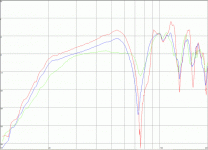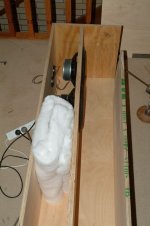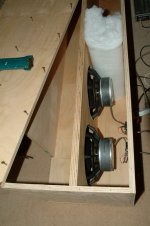tapered quarter-wave pipe theory aid bandwidth?
G'day Freddy
I’m also very big on drums with fast response & minimal overhang.
However, THs normally only cover 2 octaves up to about 60-70 Hz, below the fundamentals of even bass drums.
Still a good question ~
G'day William,
What’s your experience of the response speed & overhang of THs vs other horns or conventional alignments?
And on bandwidth, has anyone looked at the patent 3047090 which it was suggested extracts a further half an octave? http://free.patentfetcher.com/Patent-Fetcher.php?submit=Fetch&PN=3+047+090
It’s of a kind of folded horn, so I haven’t been able to see it’s relevance.
Half an octave of itself is not a lot, but it would make integration with the driver ‘above it’ a lot easier. It would be good to know why bandwidth is only 2 octaves, and if this could be stretched a little, maybe by sacrificing a modest amount of the generous efficiency.
Maybe an understanding of transmission lines (something I’ve never really looked into) esp tapered quarter-wave pipes would help. Any TL folk eg dave? MJK? reading this?
Cheers
G'day Freddy
I’m also very big on drums with fast response & minimal overhang.
However, THs normally only cover 2 octaves up to about 60-70 Hz, below the fundamentals of even bass drums.
Still a good question ~
G'day William,
What’s your experience of the response speed & overhang of THs vs other horns or conventional alignments?
And on bandwidth, has anyone looked at the patent 3047090 which it was suggested extracts a further half an octave? http://free.patentfetcher.com/Patent-Fetcher.php?submit=Fetch&PN=3+047+090
It’s of a kind of folded horn, so I haven’t been able to see it’s relevance.
Half an octave of itself is not a lot, but it would make integration with the driver ‘above it’ a lot easier. It would be good to know why bandwidth is only 2 octaves, and if this could be stretched a little, maybe by sacrificing a modest amount of the generous efficiency.
Maybe an understanding of transmission lines (something I’ve never really looked into) esp tapered quarter-wave pipes would help. Any TL folk eg dave? MJK? reading this?
Cheers
G'day Freddi and Rick
Firstly, the quality of bass from a correctly implemented tapped horn is excellent. This is also the case for low Q sealed, dipole and well designed bass horns. The design itself is not floored.
The big dip in the top end cannot be removed. We tried some damping strategies (Which partly worked but cost us sensitivity) and we also tried spacing two drivers along the horn, again which only partly worked. If you think about the four acoustic paths in a tapped horn, it's quite easy to see where the cancellation related dip comes from. The reflection off the throat of the horn from the mouth side of the driver is nearly perfect. We were getting nulls in the order of 20 to 30dB. Essentially the entire signal is being reflected back to the mouth and destructively interfering with the direct output. Tom's horns are essentially two octave devices as well. (Give or take a bit for driver choice and horn layout.)
These four paths are what makes modelling this beast so difficult. Hornresponse will only model the dominant full path. A complex sum has to be made on all four paths to generate an accurate model. I guess this is a topic for discussion elsewhere.
Cheers
William Cowan
Firstly, the quality of bass from a correctly implemented tapped horn is excellent. This is also the case for low Q sealed, dipole and well designed bass horns. The design itself is not floored.
The big dip in the top end cannot be removed. We tried some damping strategies (Which partly worked but cost us sensitivity) and we also tried spacing two drivers along the horn, again which only partly worked. If you think about the four acoustic paths in a tapped horn, it's quite easy to see where the cancellation related dip comes from. The reflection off the throat of the horn from the mouth side of the driver is nearly perfect. We were getting nulls in the order of 20 to 30dB. Essentially the entire signal is being reflected back to the mouth and destructively interfering with the direct output. Tom's horns are essentially two octave devices as well. (Give or take a bit for driver choice and horn layout.)
These four paths are what makes modelling this beast so difficult. Hornresponse will only model the dominant full path. A complex sum has to be made on all four paths to generate an accurate model. I guess this is a topic for discussion elsewhere.
Cheers
William Cowan
G'day William,
I see what you mean about cancellation causing dips and modelling being difficult.
But I’m still interested in reducing the dip in the top end, and willing to sacrifice a little of the generous efficiency.
If you get a time to post here, or a new thread, I’d love to here about the damping strategies, and how much they gained (more so if they would also work with the 830500).
Cheers
Rick
I see what you mean about cancellation causing dips and modelling being difficult.
But I’m still interested in reducing the dip in the top end, and willing to sacrifice a little of the generous efficiency.
If you get a time to post here, or a new thread, I’d love to here about the damping strategies, and how much they gained (more so if they would also work with the 830500).
Cheers
Rick
Damping a tapped horn
G'day again rick
This plot gives you an idea of what some acoustically absorbant material will do at the velocity maxima at 75Hz. Red is undamped. You reduce the dip to just 8dB, but lose 6dB of sensitivity in the process. My conclusion was that it is not worth doing.
G'day again rick
This plot gives you an idea of what some acoustically absorbant material will do at the velocity maxima at 75Hz. Red is undamped. You reduce the dip to just 8dB, but lose 6dB of sensitivity in the process. My conclusion was that it is not worth doing.
Attachments
Fred, I have a drawing of a taped horn with a cavity in front of the woofer with a K-slot in it.
If you look at the 15" model from Danley it has a deep dip at around 140hz, then comes back and is usable to about 250hz. A K-box front chamber resonates about 160hz. The same idea may help out in the taped horn (or it may not). Have to make some sawdust to find out.
If you look at the 15" model from Danley it has a deep dip at around 140hz, then comes back and is usable to about 250hz. A K-box front chamber resonates about 160hz. The same idea may help out in the taped horn (or it may not). Have to make some sawdust to find out.
Rythmik Direct Servo kit arrived yesterday. Very very impressive. It will be very good as a reference sub. I'm impressed by how clean it is, and how dynamic. It's actually better than I expected.
I hate to do this, but I think we'll have to go back to the first design. If the second needs to be twice as big, then I'll stick with the first. Or if I do build the 2nd design, probably end up just using one driver in it. Any bigger will probably be too big.
Richard, as it stands I think you have two good placement options if actually used permanently. Standing in a corner, or sitting along a wall on it's side. With the latter, you could put a TV on top and make it look just like an entertainment unit.
I hate to do this, but I think we'll have to go back to the first design. If the second needs to be twice as big, then I'll stick with the first. Or if I do build the 2nd design, probably end up just using one driver in it. Any bigger will probably be too big.
Richard, as it stands I think you have two good placement options if actually used permanently. Standing in a corner, or sitting along a wall on it's side. With the latter, you could put a TV on top and make it look just like an entertainment unit.
- Home
- Loudspeakers
- Subwoofers
- Collaborative Tapped horn project


